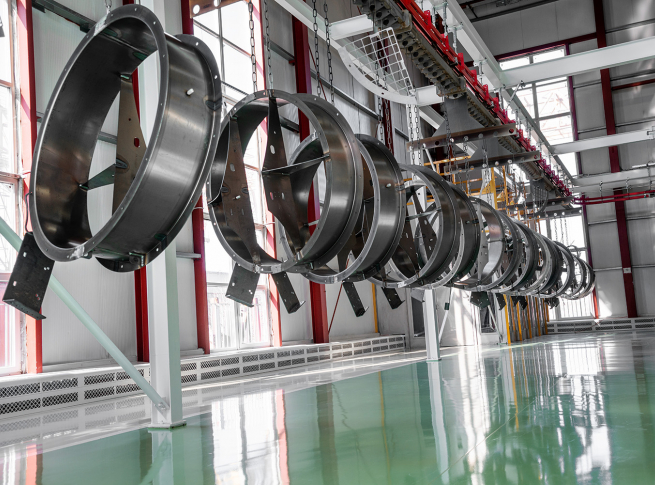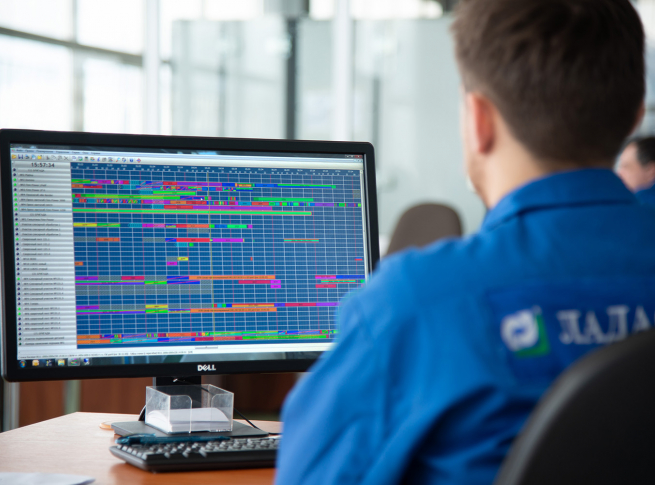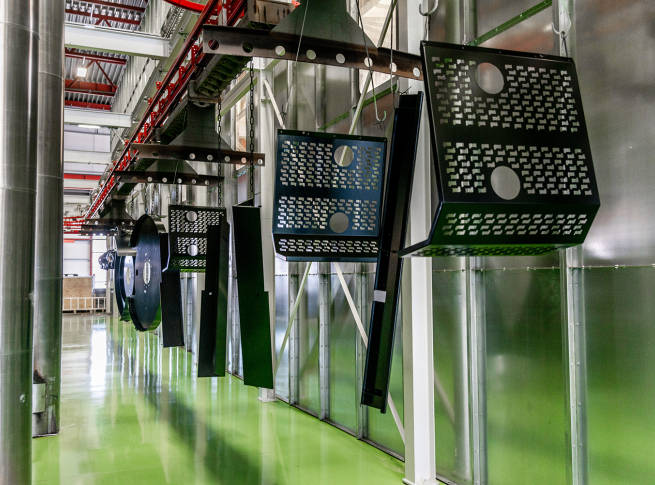PRIMA ART Line for applying a complex three-layer coating PRIMA ART
In 2018, LADA-FLAKT launched a high-tech line of complex three-layer coating PRIMA ART, which makes it possible to apply a coating resistant to aggressive environments on metal surfaces.
The corrosion resistance class of the coating is C-5M, which is confirmed by tests in a salt fog chamber for 2000 hours. Durability of the coating is more than 20 years in conditions of high corrosivity of the atmosphere, for example, in a maritime climate.
The PRIMA ART line includes: 11 reagent baths, 1 cataphoretic primer drying oven, 1 surface curing oven and 2 electroplating paint chambers.
The color palette of the complex three-layer coating complies with the international standard according to the RAL system. The color of the coating is chosen by the customer.
Conveyor line length is
400 m
Maximum size of parts to be painted is
2000×2000×2000 mm
Coating Technology
Before the metal product arrives at the PRIMA ART line, the remains of old paint, dirt and dust are removed (if necessary) under the influence of an air-abrasive jet.
Stages of work of the PRIMA ART line:
- Surface preparation of parts
- Application of zirconium coating.
- Applying a cataphoretic coating.
- Application of polymer paint.
The resulting complex three-layer coating



Stage 1. Surface preparation
The surface of the part is prepared in seven baths with active reagents, in which dirt, dust, oils and surface corrosion are removed. After cleaning, the remaining solutions are washed off with demineralized water.
Stage 2. Zirconia coating
Application of zirconium coating is one of the stages of anti-corrosion treatment of the part surface.
Zirconium saturates the surface with electrons, restores the crystal lattice of the upper layer of the part, which is damaged during thermal and mechanical processing. The presence of free electrons on the metal surface improves adhesion with the next coating layer — cataphoretic primer.
Zirconium coating thickness is
3-5 microns
Stage 3. Ctaphoretic coating
Applying a cataphoretic coating is a stage of priming a metal product to protect against rust formation. The coating has high strength and wear resistance due to penetration into hard-to-reach places, edges and pores.
Having performed rust removal at the first stage, in the future you can forget about the risks of such a damage to the product located in an environment with high relative humidity and containing sea salt.
Coating technology - the part is immersed in a bath with colloidal (greasy) solutions, when voltage is applied, the cataphoretic primer is charged, followed by the formation of a protective layer. Before drying the cataphoretic primer, the part goes through an ultraviolet bath. Drying is carried out in an oven at a temperature of 140 to 200 °C.
The uniformity of the resulting cataphoretic coating on the plane and sharp edges ranges from 25 to 45 microns.
The uniformity of the cataphoretic coating is
25-45 microns
Drying at temperature
140-200 °С
Stage 4. Polymer coating
Applicable types of paints: polyurethane, polyester, epoxy polyester, polyethylene.
Coating technology — polymer paint is applied by electrostatic deposition in a spray booth. The polymerization of the electrodeposited paint takes place in an oven at a temperature of 140 to 200 °C.
The resulting polymer coating has corrosion resistance and gives the product a decorative appearance.
The thickness of the polymer coating on the plane and sharp edges ranges from 100-120 microns.
Polymer coating thickness
100-120 microns
Control system
Quality control
Clean and lean manufacturing
A special pride is the struggle for a clean environment and minimizing harmful production waste. In our production there is a workshop for water purification after it passes through the paint shop with aggressive reagents. Water is brought to drinking quality and only after that it is partially used in the technological process, and partially discharged into the sewerage system.
Drying and baking chambers are equipped with a heat recovery system.
Hot air from the drying chamber is directed through the duct system to the baking chamber, where it is heated to the desired temperature.
Hot air from the baking chamber passes through a system of air ducts through water heat exchangers, where the water is heated, which is used in the technological process.
The thermal afterburner installed in the drying and mixing chambers operates under excess pressure, which allows afterburning carbon monoxide and solvents and minimizing the amount of harmful emissions into the environment.
Conductive copper wire is laid around the spray booths in the floor to protect the operator from accumulated static electricity.
There are no analogues of this system in the territory of the Russian Federation in the civil industry.
Corrosion test results
Corrosion tests for the resistance of a complex three-layer coating were carried out in a salt (sea) fog chamber, after which the service life of metal products with this coating was determined.
The samples were exposed to salt fog for 2000 hours without any visible damage. A complex three-layer coating does not enter into a chemical reaction with an aggressive environment, inhibits the appearance of rust.
Corrosion resistance of the coating in the salt fog chamber
2000 hours
no visible damage
Test result according to ISO 12944 for 2000 hours:
- Spread of corrosion from a notch - less than 1 mm;
- Formation of bubbles on the surface - 0 (S0);
- Formation of corrosion on the surface - 0 (SO)
- Adhesion - GT0 (100% safety)
Test result according to ISO 4628 for 2000 hours:
- Spread of corrosion from a notch - less than 2 mm;
- Formation of bubbles on the surface - 0 (S0);
- Formation of corrosion on the surface – Ri 0






